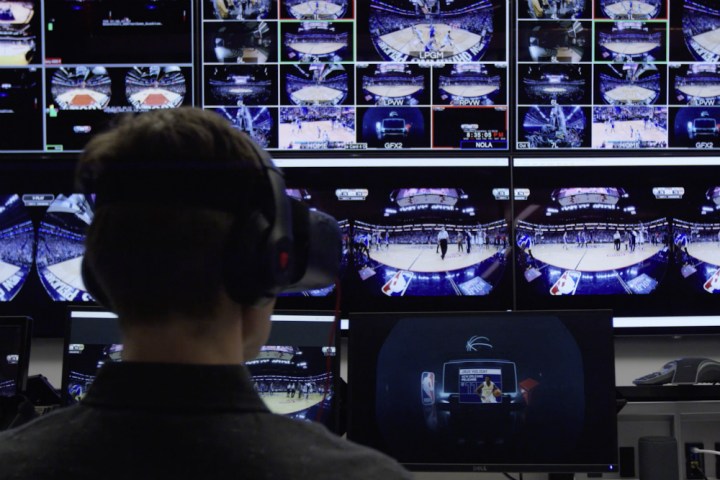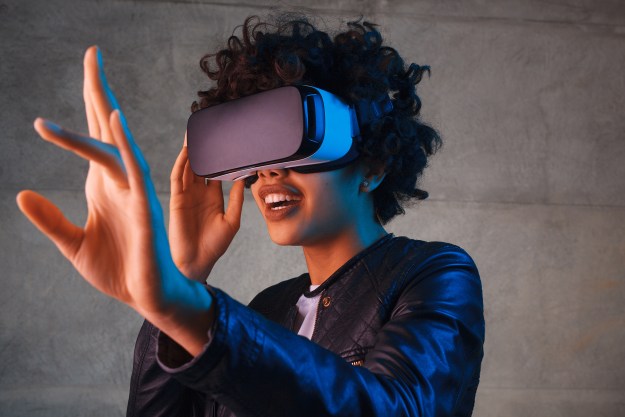
In the last few years, nearly every major sporting league dabbled in virtual reality, promising fans a better sports viewing experience than they get from “ordinary” TV. Watch boxers Canelo Alvarez and Gennady Gennadyevich Golovkin beat each other’s faces in — from atop the ring’s turnbuckle! Take in Real Madrid and Juventus’s epic duel in the 2017 Championship League Final — from behind the goalie net! Catch the NBA’s best dunkers showing off their skills in the 2017 Slam Dunk Contest — from right behind the basket!
Unfortunately, watching a game in VR is … mundane.
Sporting events in VR boil down to nothing more than stuffing a TV broadcast into a VR headset. You don’t really feel like you’re actually at a game; the action is too far from the camera, or you can’t fully look your surroundings. Worst of all, there isn’t enough worthwhile content that you couldn’t be similarly entertained by on your TV. Why bother?
But that’s just scratching the surface of what’s wrong with VR sports.
What Am I Watching?
This year, Intel live streamed an MLB game every Tuesday in virtual reality for the entire 2017 regular season, placing three to four True VR cameras around each stadium. The views mostly changed from game to game, but fans could usually tap a button and watch the game from an aerial view above home plate or views near third and first base. Howard Wright, vice president of global business development for the Intel Sports Group, told Digital Trends in September that those three views were chosen because “this is what, optically, we’re used to.” Wondering why VR doesn’t offer much fresh or different? That’s part of it right there.
Intel isn’t psychic, after all.
One problem: This isn’t TV, it’s VR, and the limitations of trying to copy a TV broadcast in virtual reality are glaringly obvious. Those True VR cams don’t zoom in, so diving centerfield catches and last-second slides into second are virtually unwatchable in VR. Worst of all, in VR, you can’t watch a home run soar into the bleachers — Intel isn’t psychic, after all. “We don’t know where the home run is going to go, but we know where the home run is going to come from,” Howard said, explaining why Intel’s cameras point towards home plate.
This isn’t just a baseball problem. When watching a football game on the sidelines in VR, I often can’t tell what’s happening on the field, because the action is too far from the camera. That problem is compounded by the fact that mobile phones compatible with the Google Daydream and Samsung Gear VR don’t have screen resolutions high enough to display the 4K quality in which these games are captured. “When I’m in the headset and I’m watching content or a highlight on the other side of the field, can I actually see what’s happening? Resolution today limits that ability,” William Deng, NFL’s Director of Media Strategy and Business Development, told Digital Trends in January.
If you can’t see everything, then what’s the point of watching in VR?
Thinking Inside The Box
If you’ve never watched a sporting event in virtual reality, let me paint you a quick picture. Cut a rectangle in a cardboard box, put it on your head, and look through it the next time you attend a live game. You’re only given a 180- to 210-degree field of view for almost every sporting event you watch in VR, with statistics, the app’s logo and other graphics filling in the blank space behind you. Sometimes players run out of your field of view, and if you’re manually choosing your view, you’ll miss out on a lot of action. Isn’t being able to choose where you watch the game the whole draw of watching sports in VR?
Plus VR is lonely. At any live game, the players are the attraction, but the fans are the atmosphere. I can’t tell you how many times I rewound Steph Curry’s near half-court game winner against the Oklahoma City Thunder in 2016 just to watch the fan reactions in the crowd. I also can’t tell you how many times I’ve attended games with horrible on-court action that were only enjoyable because I could people-watch the characters around me. Even watching a game at home by yourself isn’t as solitary as watching in VR, because you can chat with other people on social media.
If a tree falls in VR … who cares?
Give The People What They Want
I hate to say it, but even with all of its failings, VR still has immense potential to revolutionize how we watch sports. One way to do that is to truly leverage the immersive technology of VR to deliver engaging content you can’t get anywhere else. You can buy a ticket to a game, or watch it on your device of choice. But you can’t be a fly on the wall after every Cleveland Cavaliers game to get the player’s unfiltered thoughts. To do that, athletes need to be as involved in VR as they are at penning articles for websites like Jeter’s The Player’s Tribune and Lebron’s Uninterrupted.
During the 2016 NBA playoffs, Golden State Warriors superstar forward Draymond Green kept a running diary of his experience by speaking with Marc J. Spears from ESPN’s The Undefeated. When the Warriors blew a 3-1 lead in the 2016 NBA Finals to the Cavs, Green remarked “[The locker room] was stunned. Guys were looking down, [angry]. But guys were uplifting, too. This ain’t the last of us. This is just a bump in the road …” Imagine seeing those diary entries in VR every week, staring into each player’s eyes as coach Kerr delivered his final speech of the season. That would be a visceral experience that would make ESPN jealous — and fans open their wallets I’ll bet.
What about visually integrating fantasy sports profiles into the VR experience? That would keep people engaged and eliminate the need to take off the headset to check your lineup on your phone, which I suspect tens of millions of people do when watching games. A graphic displaying game stats and fantasy points could hover over each player in the game who’s on your fantasy team. Imagine if each game in which you have an active fantasy player were accessible in VR: You say you’re bored being under the basket as Lonzo Ball bricks jump shot after jump shot? You could easily click the drop-down menu, click on a different player, and be transported to a courtside seat just as Klay Thompson’s barrage of three-pointers saves your fantasy team from disaster.
Luckily, some of these problems are being worked on.
Bright Future
The Fox Sports VR app took a huge step toward social VR by allowing people to watch a game in a virtual lounge while talking to floating avatar heads that represent people sharing the experience. In the app, you can virtually hang out with either Facebook friends of yours or complete strangers.
Mobile VR is also on the precipice of a revolution with the introduction of standalone VR headsets. Mobile headsets like the Gear VR and Google Daydream provide you with only three degrees of freedom (3DOF), allowing you to look horizontally and vertically, but not move in a 3D space. Standalone VR headsets that require no phone, such as the upcoming Oculus Go, offer six degrees of freedom (6DOF) allowing you to move up, down, left, right, backward, and forward in a 3D space. NextVR co-founder and CEO David Cole is bullish on the potential such standalone VR headsets can have on sports. “For instance, you are watching our center court camera feed and something obstructs the camera — like if a ref stands in front of the camera — you can physically move your body and look around it,” Cole told Digital Trends in June.
In a year, you could potentially be running around Yankee Stadium before a game, or even following along with the Dallas Cowboys. But it’s just as likely that none of this happens. Meanwhile, I’m not giving up my season passes.
Editors' Recommendations
- Can the Quest 3 replace my laptop for work? I found out the hard way
- Here’s why Apple’s VR headset may become an ‘expensive flop’
- Doing work in VR never made sense, and now we know why
- This futuristic haptic vest should make virtual reality feel more realistic
- Pimax’s 12K QLED VR headset wants to take virtual reality to the next level



